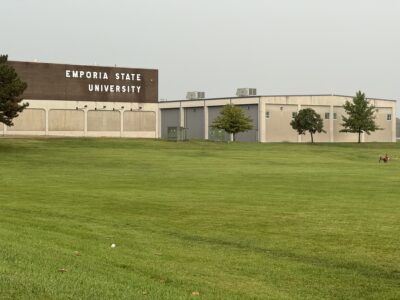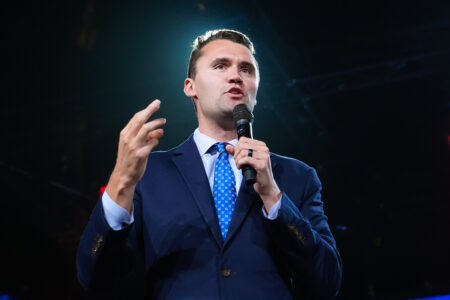Kansas governor announces cuts to public schools, higher ed

In this Jan. 23, 2014 file photo Kansas Gov. Sam Brownback, left, leans in to listen to Xen Hesse as the two each lunch at Roesland Elementary School in Roeland Park, Kan.
Topeka ? Republican Gov. Sam Brownback said Thursday he would cut spending on Kansas’ public schools and universities and GOP legislators approved a plan to shift around money to plug a budget hole as the state scrambled to cope with a revenue shortfall following aggressive tax cuts.
The spending cuts announced by Brownback and a budget-balancing bill approved by the Republican-controlled Legislature would erase a $344 million deficit projected for June 30, against spending of about $6.3 billion. Top Republicans said lawmakers needed to approve a fix for the current budget by Feb. 13 to ensure the state pays its bills on time through the summer.
Their actions also buy time to address a projected shortfall of nearly $600 million in the budget for the state’s next fiscal year, which begins July 1. Brownback has proposed slowing down future income tax cuts and boosting tobacco and alcohol taxes, and many GOP lawmakers want to pursue further spending cuts.
The governor announced his planned education cuts just minutes before the Senate convened to debate lawmakers’ budget-balancing plan. The Senate approved the bill, 24-13, after the House passed it Wednesday on an 88-34 vote, with only GOP support in both chambers. Brownback is expected to sign the measure.
Brownback said he would reduce aid to public schools by $28 million, dropping base state aid by nearly $42 per student. The reduction would come after lawmakers last year boosted aid to poor school districts to comply with a Kansas Supreme Court order in a 2010 lawsuit filed by parents and school districts. The remainder of the $45 million in education cuts would come from higher education.
Deputy Education Commissioner Dale Dennis said the allotment cuts to public schools will apply directly to the base state aid that each district receives.
According to a spreadsheet prepared by the department, the Lawrence school district would lose $598,962 through the allotment. The Eudora school district loses $81,638, and the Baldwin City school district loses $75,188.
Lawrence Superintendent Rick Doll said he was still analyzing where the district would make cuts to absorb the allotments, but he said it would likely involve freezing certain budgets and accessing the district’s reserve funds.
For Kansas University, the allotment means a reduction of $2.7 million for the Lawrence campus and nearly $2.1 million for the medical school in Kansas City, Kan.
“It’s disappointing to a lot of Kansans that cuts like these are being made, not only because they hurt families’ ability to afford college, but also because of the lost growth that results from not investing in workforce development and job creation,” said KU spokesman Tim Caboni.
“If the state is banking on economic growth to end this crisis, then that makes supporting Kansas’ universities, which are engines of prosperity, even more important,” Caboni added. “Our graduates power the workforce, and our discoveries lead to new jobs, treatments and companies, so cutting universities only serves to hurt Kansans’ health and prosperity.”
Brownback’s Kansas experiment was hailed by some national conservatives in 2012 and 2013 when he championed personal income tax cuts to stimulate the economy, dropping the top rate by 29 percent and exempting 191,000 business owners altogether. Revenue has since fallen short of forecasts, and Brownback won a closer-than-expected re-election in a heavily Republican state last year after arguing that the tax cuts would not hurt schools or sacrifice core government services.
Some Republicans have backed away from using Kansas as a tax-cutting example now that the state faces a fiscal crisis.
“We are not doing what Kansas did,” South Carolina Republican Gov. Nikki Haley said last week. She is proposing deep cuts in income taxes — but phased in over 10 years. Brownback announced Thursday that he would trim nearly $45 million from the current budget for public schools and higher education on March 7 but encouraged lawmakers to find an alternative. Lawmakers’ budget-balancing plan attacks the current budget’s deficit largely by diverting money from highway projects, contributing less to public pensions and shuffling dollars to cover spending on education, social services, prisons and other programs.
The governor has blamed a wide range of budget and revenue surprises for the state’s financial problems, rather than the tax-cutting he championed. But some GOP allies link the deficits to the tax cuts — and say it’s good that government revenues are pinched.
“We’re taking less (in taxes), which does leave some difficult decisions,” said Sen. Ty Masterson, an Andover Republican and chairman of the budget-writing Ways and Means Committee.
Meanwhile, the promises made to school districts last year turned out to be more expensive than anticipated, and Brownback and his allies argue they’re not shortchanging schools. The governor said in a statement that he wants lawmakers to “reform” state funding to avoid “unsustainable” increases in spending.
But Topeka schools Superintendent Julie Ford said her district — which would lose $813,000 — would have to consider closing smaller schools and canceling summer school programs and programs for at-risk children.
The state’s higher education system would lose $16 million. Senate Minority Leader Anthony Hensley, a Topeka Democrat, predicted tuition would rise.
“There is a war going on against public education,” Hensley said.






